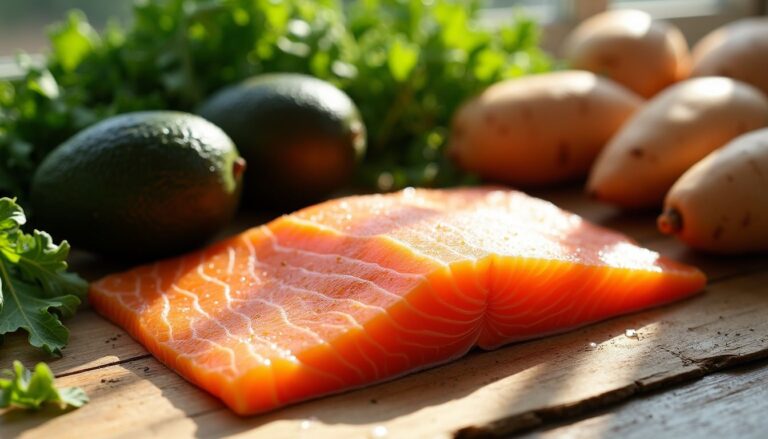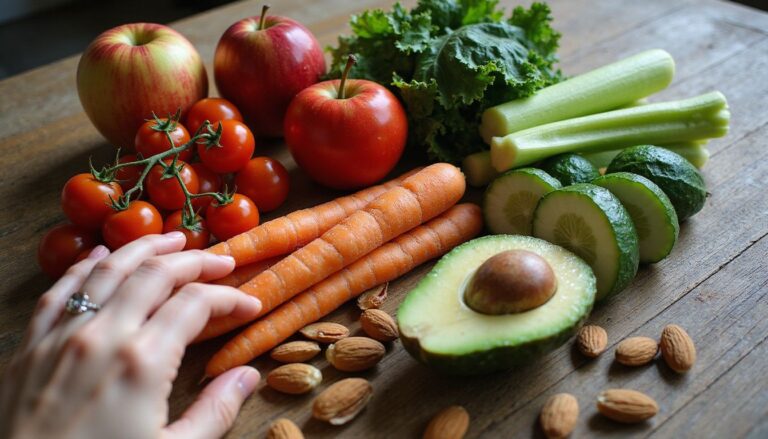7-Day Diet Plan To Lose 5 Kg: Effective Weight Loss Meal Plan
Our Nutrition Assistant AI Suite will transform your body. You will lose fat, get toned, and build muscle. Gain confidence and optimal health.
You want to lose weight fast, but most plans feel confusing. A structured diet plan can help you drop up to 5 kg in one week if you manage calories and stick to simple meals. This 7-day weight loss guide gives you clear steps, easy meals, and practical tips to get started today.
Key Takeaways
- The 7-day diet plan uses daily menus with fruits, vegetables, lean proteins, and whole grains to help you lose up to 5 kg in a week.
- A calorie deficit of 500 to 1000 calories per day supports losing 1 to 2 pounds per week. Faster loss is possible for people with a higher starting weight.
- Drink 8 to 10 glasses of water daily, eat high-fiber foods, and avoid processed, sugary, or fried items to support rapid weight loss.
- Balance nutrients by pairing produce, lean protein, and whole grains; watch portions and track your intake.
- Light exercise and 7 to 9 hours of sleep each night can improve results and reduce weight regain.

What is a 7-Day Diet Plan?

A 7-day diet plan is a short program designed to support quick weight loss. Each day highlights certain food groups, which makes choices simple and helps limit calories.
What is the 7-day diet plan overview?
This plan centers on fruits, vegetables, lean proteins, and whole grains like brown rice. Many people follow it to try to lose up to 5 kg in one week by creating a calorie deficit and cutting high-calorie foods.
Processed snacks, fried items, and sugary drinks are limited or removed. Hydration matters, so aim for at least 10 glasses of water per day to manage hunger and support your body’s normal cleansing process. Some programs set daily themes, such as fruit only on Day 1 or bananas with milk on Day 4. The structure removes guesswork and keeps you on track.
How does the 7-day diet plan help with weight loss?
The plan helps you eat fewer calories than your body uses. This is called a calorie deficit. When this happens, your body taps stored fat for energy. Simple rules and set meals reduce overeating and mindless snacking.
Meals focus on low-calorie vegetables and fruits plus moderate protein and whole grains. Stable blood sugar can curb cravings. Replacing sugary drinks with water lowers calorie intake and supports metabolism. Most steady plans lead to 0.5 to 1 kg per week, although some people see faster loss at the start due to water weight.
Benefits of a 7-Day Diet Plan
A 7-day diet plan can fit a busy life. You get quick feedback, which can build motivation for continued healthy eating.
How quickly can I lose weight on this diet?
Many people report losing 2 to 5 kg in one week on a low-calorie plan like the sample GM diet. Early losses are often water weight as you reduce salt and refined carbs. Calorie deficits of 500 to 1000 calories per day usually produce 1 to 2 pounds per week. Larger starting body sizes may see quicker changes at first.
Hydration, sleep, activity level, and starting body composition all affect results. Progress varies, but most people notice changes in seven days if they follow the plan closely.
How does this diet detoxify the body?
Eating more fruits and vegetables supports your body’s natural detox systems. These foods supply antioxidants, fiber, and water. Fiber from leafy greens and whole grains helps your gut move waste efficiently.
Drinking enough water supports the kidneys and helps remove waste through urine and sweat. Cutting ultra-processed foods and added sugars reduces the load on the liver and kidneys. As Dr. Mark Hyman states, “Food is not just fuel; it’s information for our bodies.” Clean eating lets your body focus on normal cleanup, not breaking down heavy fried foods.
How does the diet improve digestion and metabolism?
High-fiber foods move through your digestive tract and help prevent constipation and bloating. Better digestion can also improve nutrient absorption. Lean protein, like chicken, fish, eggs, or cottage cheese, requires more energy to digest than carbs or fat. This effect can slightly increase calorie burn.
Water helps break down food and transport nutrients. Choosing fiber-rich vegetables such as carrots, peas, and spinach can steady appetite and support a low-calorie plan. Balanced meals also help keep blood sugar more stable, which reduces crashes and cravings.
Can this diet increase my energy levels?
Many people feel more alert when they switch to nutrient-dense meals. Fresh produce brings vitamins and minerals that support energy. Complex carbs like brown rice and lentils provide steady fuel without the quick crash you get from sugary snacks.
On Day 3, my energy improved after mixing fruits and vegetables at each meal. A simple soup on Day 6 kept me hydrated for a short walk that afternoon.
Key Principles of the Diet
Knowing these basics helps you follow the plan with confidence and avoid common mistakes.
What role does a calorie deficit play in this diet?
A calorie deficit is the core of this plan. You eat less than you burn, so your body uses stored fat for energy. A daily deficit of 500 to 1000 calories often leads to losing 1 to 2 pounds per week.
Tracking your intake can show which foods keep you full and make sticking to your calories easier. Pair eating changes with light activity like walking to support steady progress.
How do I ensure balanced nutrient intake?
Build each meal with protein, complex carbs, and healthy fat. For example, oatmeal with milk at breakfast, a boiled egg for a snack, and a mixed vegetable bowl at lunch. Public health guidance suggests filling half your plate with fruits and vegetables.
Mix in small amounts of nuts or seeds for fullness. Low-fat yogurt or a few slices of avocado add healthy fats without much sugar. Plant proteins like beans, lentils, and tofu boost fiber and amino acids. Drinking water before meals can help with appetite control and digestion.
Why is adequate hydration important?
Hydration aids metabolism, reduces false hunger, and supports kidney health. It may help you avoid overeating by adding volume before meals.
If you exercise lightly, fluids also protect against dehydration. Aim for 8 to 10 glasses of water per day during this 7-day meal plan.
Detailed 7-Day Diet Plan to Lose 5 Kg
This day-by-day plan focuses on fresh produce, lean proteins, and whole grains. It creates a calorie deficit and keeps meals simple.
What should I eat on Day 1 with fresh fruits?
Day 1 is fruit only. Fruits provide natural sugars for energy and fiber for fullness.
- Choose a variety like apples, oranges, watermelon, papaya, cantaloupe, and berries.
- Avoid bananas and potatoes on Day 1 since they are higher in calories.
- Have one fruit serving every two to three hours to manage hunger.
- Pick whole fruit instead of juice or shakes to get fiber and avoid sugar spikes.
- Drink water often to support digestion and natural cleansing.
- If you track carbs for diabetes, pick lower-sugar fruits like berries or green apples.
- Skip added sugar and avoid artificial sweeteners.
- Pack pre-cut fruit for work or school so you do not skip meals.
- Keep portions to about one cup per serving to support a calorie deficit.
- Track your intake in a journal or app for awareness and consistency.
What vegetables are best for Day 2?
Day 2 is vegetable only. Pick high-fiber, low-calorie options to control hunger and support weight loss.
- Leafy greens like spinach, kale, and lettuce offer volume and few calories.
- Broccoli, cabbage, and cauliflower support digestion and steady weight loss.
- Carrots supply beta-carotene and work well raw or steamed.
- Bell peppers add vitamin C without extra sugar.
- Cucumbers hydrate and may reduce water retention.
- Zucchini and squash are filling when grilled or steamed with little oil.
- Green beans add fiber and a small protein boost.
- Tomatoes supply antioxidants like lycopene and key vitamins.
- A single serving of boiled sweet potato can be included if you need a starch.
Keep seasonings simple. Use herbs, lemon, vinegar, and a light spray of oil if needed.
How to combine fruits and vegetables on Day 3?
Day 3 blends fruits and vegetables. Avoid potatoes, bananas, and heavy dressings.
- Start with a bowl of leafy greens and sliced apples or berries at breakfast.
- Make a large salad with tomatoes, cucumbers, carrots, melon, and orange segments for lunch.
- Snack on fresh fruit like watermelon or pineapple between meals.
- Cook a simple stir-fry with bell peppers and spinach for dinner, using minimal oil.
- Enjoy one small fruit smoothie with unsweetened plant milk if desired.
- Drink water or herbal tea often to support hydration.
- Skip cheese, butter, and creamy dressings to keep calories in check.
What is the Day 4 banana and milk plan?
Day 4 focuses on bananas and milk. These foods provide potassium, calcium, and steady energy.
- Eat 6 to 8 ripe bananas spaced across the day.
- Drink 3 to 4 cups of low-fat milk. Choose soy or almond milk if you prefer a plant option.
- Stick to bananas and milk so your digestive system can rest.
- Bananas supply potassium and fiber, which can reduce cramps and keep you full.
- Milk adds quality protein and calcium for bone health.
- Use water between feedings to manage hunger and hydration.
- Natural sugars in bananas can help prevent fatigue during a calorie deficit.
- If you follow a low-carb plan, note that bananas are higher in carbs.
- Ask a clinician for advice if you are very active or have special needs.
- I had a mild headache in the afternoon. It eased after an extra glass of water.
- The next day will shift focus to higher protein choices.
Which high-protein foods to eat on Day 5?
Day 5 centers on protein to control hunger and protect muscle.
- Have boiled eggs or a veggie omelet for breakfast. Eggs provide all essential amino acids.
- Choose grilled skinless chicken breast or turkey for lunch and dinner.
- Add low-fat Greek yogurt or cottage cheese for calcium and protein.
- Pick tofu or tempeh if you prefer plant protein.
- Include beans or lentils, such as chickpeas or black beans, for fiber and protein.
- Snack on a small handful of almonds or walnuts for healthy fats.
- Drink water to support digestion, especially with higher protein intake.
What lean meats or plant proteins are suitable for Day 6?
Day 6 continues with lean protein. Combine it with plenty of vegetables.
- Skinless chicken or turkey offers about 22 to 24 grams of protein per 100 grams.
- White fish like cod or fatty fish like salmon provide protein and helpful fats.
- Tofu or tempeh gives 10 to 19 grams of protein per serving.
- Lentils or chickpeas add around 15 grams of protein per cooked cup.
- Egg whites deliver protein with little fat.
- Low-fat cottage cheese contains about 14 grams per half cup.
- Quinoa supplies a complete grain with about 8 grams per cooked cup.
- Avoid fried meats and high-sodium processed products.
- Pair proteins with leafy greens for balanced meals.
How to plan Day 7 with brown rice, fruits, and vegetables?
Day 7 blends brown rice with fruits and vegetables to close the week with balance.
- Prepare one to two servings of brown rice for main meals.
- Add several servings of leafy greens and colorful vegetables across the day.
- Include two to three servings of fruit for snacks or dessert.
- Use boiling, steaming, or baking to limit extra fat.
- Drink water throughout the day to support metabolism.
- Limit processed items and keep salt low to reduce bloating.
- Make a simple food log and note your hunger levels and portions.
Once you finish, shift your focus to maintaining progress with smart habits.
Tips for Following the Diet Plan Successfully
A bit of planning prevents last-minute choices that can derail your week.
How can I plan my meals ahead of time?
Planning meals makes this plan easier and reduces stress during busy days.
- Write a daily menu for breakfast, lunch, dinner, and snacks based on the 7-day schedule.
- Shop for fresh produce, brown rice, lean proteins, and unsweetened plant milk before Day 1.
- Batch-cook and portion meals to reduce impulsive eating.
- Use a meal calendar or food diary to track calories and portions.
- Set reminders for meal and snack times to avoid long gaps and grazing.
- Wash and cut produce for quick access, especially for Day 3.
- Cook grains like brown rice or quinoa in larger batches.
- Include variety from the start to prevent boredom.
- Read labels and avoid products with added sugar and refined flour.
- Pack meals if you will be eating away from home.
- Follow portion sizes based on credible nutrition guidance.
What processed and sugary foods should I avoid?
Skip soda, candy bars, pastries, cookies, and sugary cereals. These add a lot of sugar and few nutrients. A single can of soda can contain around 39 grams of sugar, which is more than nine teaspoons.
Avoid instant noodles, packaged cakes, chips, frozen pizzas, and processed deli meats. These often include excess sodium and unhealthy fats. During my plan last year, swapping granola bars for fruit cut my sugar cravings in half.
What types of light exercise are recommended?
Choose gentle activities that support your plan without leaving you exhausted.
- Walk at a steady pace for 20 to 30 minutes most days.
- Try yoga or stretching for mobility and stress relief.
- Use a bicycle or a stationary bike for low-impact movement.
- Swim or do water aerobics for joint-friendly exercise.
A short walk after meals can ease cravings and help digestion. Simple routines fit into busy schedules and keep momentum strong.
How much rest and sleep do I need?
Adults need 7 to 9 hours of sleep for healthy weight loss. Less sleep can raise hunger hormones and make sticking to your plan harder.
Go to bed at the same time each night and limit screens before sleep. Short daytime naps under 30 minutes can help if needed.
Foods to Include in Your 7-Day Meal Plan
Choosing the right foods supports steady progress and better digestion.
What fresh fruits are best for this diet?
Pick fruits that are low in calories but high in fiber and water. Apples, oranges, berries, melons, grapefruit, pears, and kiwi are standouts. They help you feel full with fewer calories. A medium apple has about 95 calories and over 4 grams of fiber.
Watermelon provides hydration and natural sweetness. During my first trial, grapes or pineapple at breakfast helped me avoid mid-morning snacks. Bananas are higher in calories, so watch portions if you include them.
- Top fruit picks: apples, oranges, berries, watermelon, cantaloupe, grapefruit.
- Main benefits: fiber and water boost fullness.
- Example: a medium apple has 95 calories and more than 4 grams of fiber.
- Personal note: grapes or pineapple reduced morning hunger for me.
Which leafy greens and colorful vegetables should I eat?
Choose spinach, kale, Swiss chard, and romaine lettuce. These greens deliver fiber and vitamins A and K plus iron. Add arugula or collard greens to salads for flavor and nutrients.
Colorful vegetables like bell peppers, carrots, beets, tomatoes, broccoli, purple cabbage, and zucchini supply vitamin C and helpful plant compounds. Variety matters for nutrient intake. Plates that include several colors can raise key nutrients compared with one-color meals.
What are the best lean protein options?
Skinless chicken breast, turkey breast, and white fish are reliable lean choices. Each offers a lot of protein with little saturated fat. Cod and other white fish are very lean. Salmon adds helpful fats along with protein.
Plant options include lentils, chickpeas, tofu, tempeh, and edamame. One cup of cooked lentils has about 18 grams of protein and almost no cholesterol. Greek yogurt and cottage cheese round out lean dairy options that support fullness.
Which whole grains fit into this meal plan?
Brown rice, quinoa, and oats work well. Brown rice provides fiber and B vitamins. Quinoa supplies protein and essential amino acids that help protect muscle. Oats offer slow-release carbs for steady energy.
You can rotate in whole wheat bread or barley for variety. Whole grains have a lower glycemic impact than refined grains, which helps with weight management.
Should I choose low-fat dairy or plant-based milk?
Low-fat dairy milk has protein, calcium, and vitamin D. It helps with bone and muscle health. If you avoid dairy, choose fortified plant milks like soy, almond, or oat.
Soy milk is closest to dairy in protein. Almond and oat milks are lower in calories, but they have less protein. Select unsweetened versions to avoid added sugar. Many people find low-fat dairy more filling due to its higher protein content, which can help with appetite control.
Foods to Avoid During the Diet
A few items can slow progress even when the rest of your plan looks strong.
Why avoid sugary drinks and snacks?
Sugary drinks and snacks are high in added sugars and calories but low in nutrients. They cause blood sugar spikes and drops, which trigger hunger and cravings. Even one soda per day has been linked with higher weight gain risk.
These choices can push you out of a calorie deficit. Replace them with whole foods such as fruit, nuts, or yogurt to support your plan.
What makes fried and oily foods unhealthy here?
Fried foods are calorie dense and often contain harmful fats. Extra calories from oils can slow fat loss. Frequent fried food intake can raise LDL cholesterol, which is risky for heart health.
High-heat frying can form compounds like trans fats or acrylamide. Swapping fried snacks for baked or steamed sides helped me avoid energy crashes and improved my results.
Why skip refined carbohydrates?
Refined carbs, like white bread, pastries, and sugary cereals, have most of their fiber removed. They digest quickly and spike blood sugar. Hunger returns fast, which can lead to overeating.
Replacing refined grains with whole grains supports fullness and steadier energy. I noticed fewer cravings after switching from white rice to brown rice or quinoa.
How does alcohol affect the diet?
Alcohol adds empty calories, about 100 to 150 per drink, and brings little nutrition. It can lower willpower and prompt high-calorie snacking.
Your body also burns alcohol first, which slows fat burning. Avoiding alcohol during this week often improves results and reduces bloating.
Potential Side Effects to Be Aware Of
Rapid changes can bring short-term effects. Monitor how you feel and adjust as needed.
What causes temporary fatigue or headaches?
Eating fewer calories can reduce energy at first. Skipping meals or cutting carbs quickly may lower blood sugar and trigger headaches. As your body uses more fat, it produces ketones, which can cause mild discomfort for some people.
Dehydration is another common cause. Many people also get headaches from sudden caffeine changes. Space meals evenly and drink water throughout the day.
How can I prevent possible nutrient deficiencies?
Build variety into your meals. Mix fruit, leafy greens, lean meats or plant proteins, and whole grains. Pair iron-rich foods like spinach with a vitamin C source for better absorption.
Use dairy or fortified plant milks for calcium and vitamin D. Rotate produce and proteins through the week so you do not rely on one food. If low energy or hair changes persist, speak with a registered dietitian for guidance.
When should I consult a doctor before starting?
Talk with your doctor if you have diabetes, heart disease, high blood pressure, thyroid issues, or take prescription medicine. People who are pregnant, breastfeeding, under 18, or with a history of eating disorders should get medical advice before starting any strict plan.
I once tried a rapid plan without support and felt dizzy by Day 3. A nutrition expert later explained why monitoring was important for my thyroid.
How to Maintain Weight Loss After the 7-Day Plan
Your next goal is to keep the progress you made. Small daily habits make the biggest difference.
How do I transition to a balanced, sustainable diet?
Bring back a variety of whole foods. Include fruits, vegetables, lean proteins like chicken or beans, and whole grains such as brown rice or quinoa. Cook at home often so you control portions and ingredients.
Drink water with every meal and use smaller plates to manage portions. Track your meals for a few weeks to see what works and what does not.
What types of regular physical activity help maintain weight?
Brisk walking, jogging, cycling, and swimming help maintain results. Aim for 150 to 300 minutes of moderate activity each week. If you prefer vigorous activity, target at least 75 minutes weekly.
Strength training twice per week builds muscle and supports your resting metabolism. Daily actions, like taking the stairs and short walks after meals, add up. A local walking group helped me stay consistent because it was social and fun.
How can I effectively monitor portion sizes?
Use smaller plates and bowls. Research shows a 9-inch plate can reduce intake by up to 22 percent. Measure servings with cups or a kitchen scale for foods like rice, pasta, and nuts.
Check labels for serving sizes before eating packaged foods. A deck of cards is about the size of three ounces of meat. At restaurants, split large portions or pack half to go.
Conclusion
A focused 7-day diet plan can help you lose up to 5 kg when you manage calories, choose nutrient-dense foods, and stay hydrated. Build meals around fruits, vegetables, lean proteins, and whole grains. Short-term calorie deficits can produce rapid changes, although most healthy plans aim for steady loss over time. Add light exercise and solid sleep for better results and long-term weight management.
Health information here is general and for education. If you have medical conditions or take medications, seek advice from a healthcare professional before starting a rapid weight loss plan.
References: [1] Dulloo AG et al., “Pathways from weight fluctuations to metabolic syndrome: Effects of repeated dieting,” International Journal of Obesity, 2012.
FAQs
1. How does the 7-day diet plan help you lose 5 kg safely?
The 7-day diet plan uses calorie control, balanced nutrition, and portion management to create a calorie deficit. Research shows that reducing daily intake by about 500 to 1000 calories can lead to weight loss of one to two pounds per week. The meal plan includes lean proteins, whole grains, fruits, and vegetables for steady energy and satiety.
2. What foods are included in an effective weight loss meal plan?
An effective weight loss meal plan features nutrient-dense foods such as grilled chicken breast instead of processed meats; brown rice or quinoa instead of white bread; leafy greens like spinach or kale; low-fat dairy products; beans for fiber; berries for vitamins; and healthy fats from nuts or olive oil.
3. Is it possible to maintain muscle while following this diet?
Yes, including adequate protein at each meal helps preserve muscle mass during calorie reduction. Studies suggest consuming at least 1.2 grams of protein per kilogram of body weight supports muscle retention when losing fat.
4. Can I adapt the meal plan if I have dietary restrictions?
You can modify the diet by swapping animal-based proteins with plant-based options like lentils or tofu if you follow a vegetarian pattern. For gluten intolerance, choose gluten-free grains such as brown rice or millet instead of wheat-based items.
Summary:
A structured seven-day eating strategy focuses on nutrient-rich choices and controlled portions for safe fat loss while supporting overall health needs through evidence-backed guidelines and adaptable food selections based on individual requirements.







